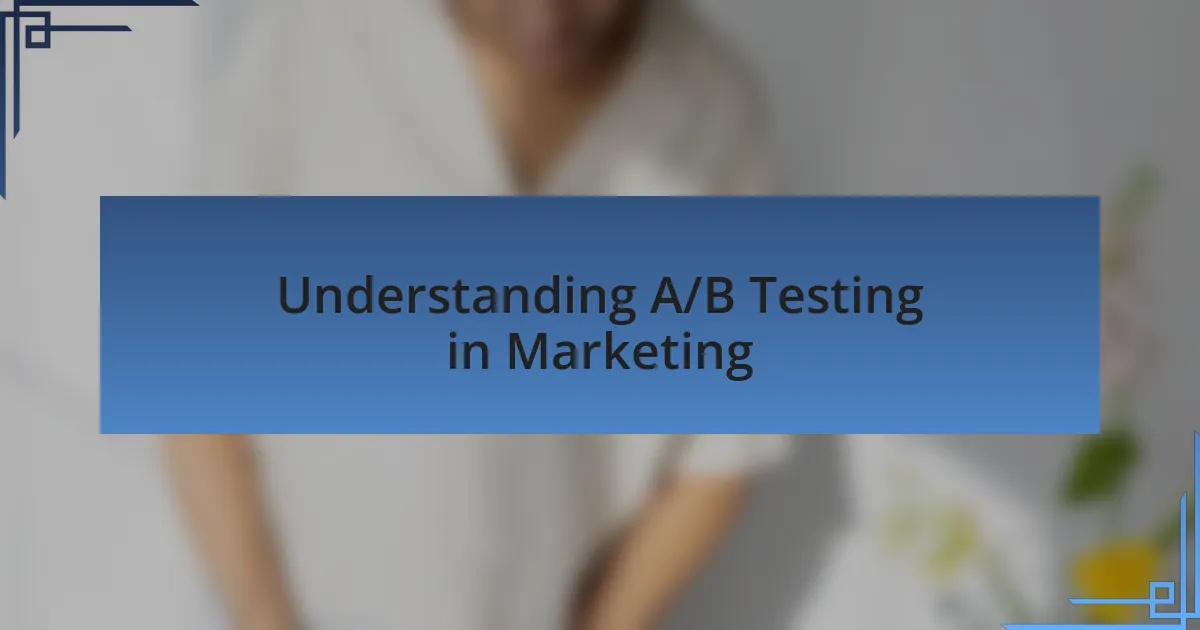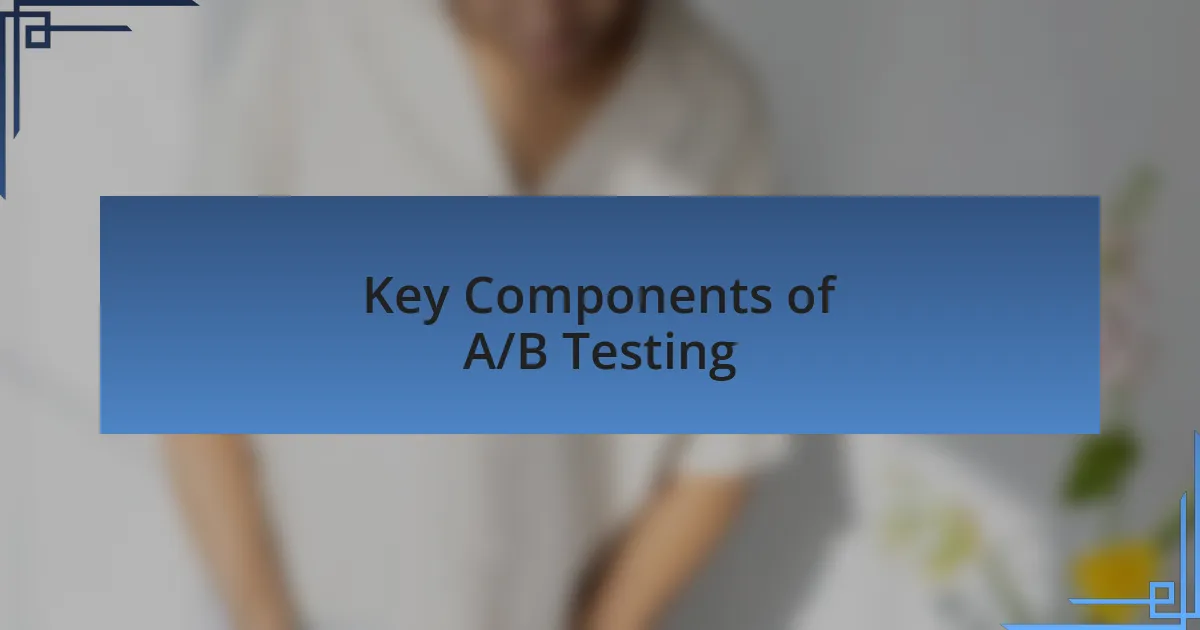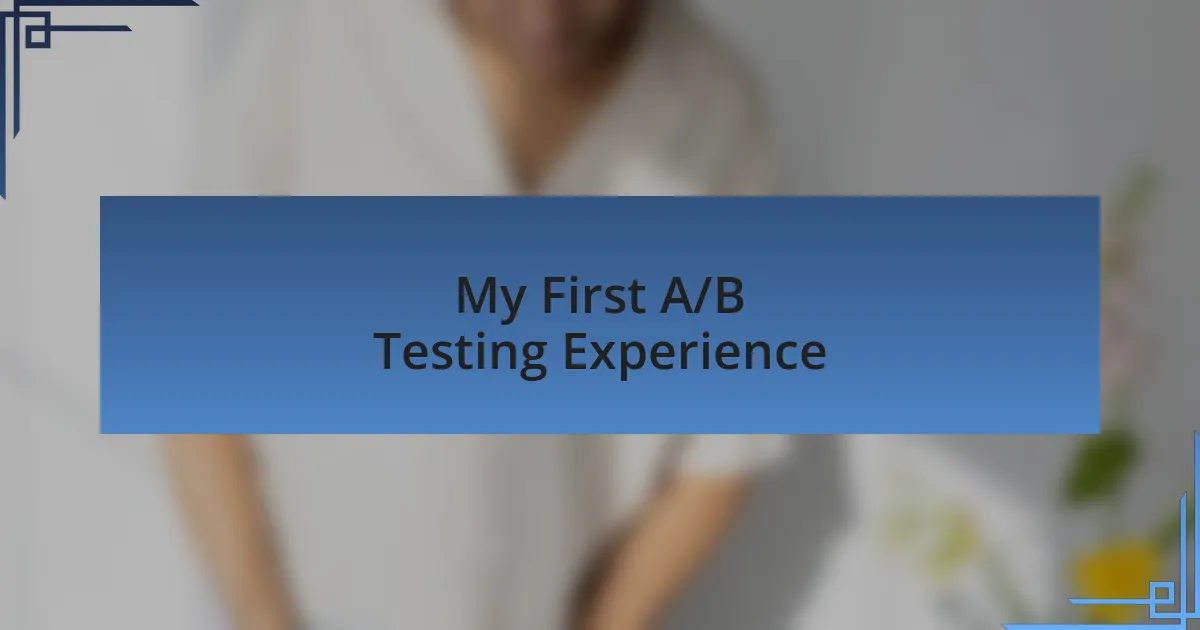Key takeaways:
- A/B testing is about understanding audience preferences, not just making superficial changes.
- Success in A/B testing relies on a clear hypothesis, appropriate sample size, and proper timing.
- Iterating on findings increases the potential for new insights and future campaign opportunities.
- Simplicity is key; focus on one variable at a time for clearer results.

Understanding A/B Testing in Marketing
A/B testing is a powerful tool that allows marketers to compare two versions of a campaign to see which one performs better. From my experience, it’s not just about changing colors or text; it’s about asking the crucial question: what resonates with my audience? I remember a campaign where a simple change in the call-to-action button increased our conversion rates significantly.
Delving into A/B testing can feel overwhelming at first, but think of it as an experiment to understand your audience better. I once hesitated to test a landing page because I feared the results would contradict my instincts. However, I learned that even small tweaks can lead to big insights. Have you ever been surprised by the outcome of a test that challenged your assumptions?
Understanding A/B testing means embracing a mindset of continuous improvement. Each test is not just a metric but a story about what your audience wants. I found that by regularly implementing A/B tests, I was able to keep the conversation with my audience alive, evolving our strategies based on their real preferences instead of just assumptions. What insights do you think could transform your current marketing approach?

Key Components of A/B Testing
When diving into A/B testing, I’ve found that a clear hypothesis is essential. For instance, during a recent email campaign, I was convinced that changing the subject line could boost open rates. By defining what I expected to happen, I set a clear direction for the test, illuminating not just the “what” but the “why” behind it. Isn’t it fascinating how a well-defined hypothesis can steer your focus?
Another crucial component is sample size. I remember being eager to test a new approach but realized too late that my sample group was too small to yield reliable results. It’s a mistake I’ve learned from: the bigger the sample, the more confident you can be about the insights. Have you ever wondered if your results reflected the broader audience or just a fluke?
Finally, I can’t stress enough the importance of timing in A/B testing. I once launched a split test just before a holiday season, thinking it would attract more participants. Instead, audience behaviors were unpredictable due to distractions from celebrations. From that experience, I understood that timing can impact not only participation but also the quality of data collected. When do you think is the best moment for your brand to initiate a test?

My First A/B Testing Experience
My journey with A/B testing began somewhat by accident. I vividly recall my first attempt, where I chose to alter a landing page’s call-to-action button color—from blue to green—hoping to see an impact. I was buzzing with excitement as I awaited results, only to discover later that my small audience actually preferred the good old blue. What a humbling realization that was!
During that initial campaign, I experienced a mix of nerves and anticipation. Watching the data roll in felt like waiting for exam grades, each update a little heartbeat. Did I really think the color change would make a difference? I learned that even seemingly minor tweaks require more than just intuition; they need solid data to back them up. Have you ever felt that rush of adrenaline linked to uncertainty in your marketing decisions?
As I reflected on my A/B testing foray, one thing became crystal clear: patience is key. The number crunching and analysis took longer than I expected, which taught me to appreciate the process. Rushing to conclusions without adequate time for reflection can lead to misguided strategies. Do you find yourself speeding through results, or have you taken a step back to truly understand what the numbers are telling you?

Lessons Learned from A/B Testing
One major lesson I took away from my A/B testing experiences is the power of audience understanding. Early on, I assumed that what I preferred would resonate with my audience too. I remember launching a campaign targeting millennials with a trend-driven design, only to realize that my older audience found it overwhelming. Have you ever thought you knew your audience well, only to be surprised by their preferences? This experience underscored the importance of knowing your target demographic inside and out.
Another point that stood out during my testing journey was the need for clear objectives. In one campaign, I aimed to increase sign-ups, but I forgot to define what success looked like. Instead of tracking conversion rates accurately, I got sidetracked by metrics that didn’t paint the full picture. It was a tough pill to swallow, but clarity of goals truly makes all the difference. Have you faced a situation where a lack of focus led to fuzzy results?
Finally, I can’t emphasize enough the necessity of iterating on findings. I used to think that once a test was complete, I had my answers. The truth, however, is that each result presents new questions. After my most successful test, I realized that the insights gained could inspire entirely new campaigns. Isn’t it fascinating how one small victory can open the door to further exploration? This concept of continuous learning is integral to mastering A/B testing.

Tips for Successful A/B Testing
When it comes to successful A/B testing, I’ve learned that simplicity is often the key. I recall a test where I tried to change too many elements at once, hoping for a groundbreaking revelation. What I ended up with was confusion and ambiguous results. Have you ever rolled out a complex test and wondered why the data seemed so murky? Sticking to one variable at a time can clarify the impact of each change and lead to more reliable insights.
Another crucial tip I’ve picked up is the importance of sample size. In one of my earlier campaigns, I was eager to see results quickly, so I tested on a small group. The outcomes were so skewed that I almost made misguided decisions based on that limited data. Have you ever jumped the gun with a tiny dataset? Ensuring a proper sample size gives your findings credibility and allows for more accurate interpretations.
Lastly, I’ve found that timing can greatly affect your test results. I once launched a campaign for a holiday promotion but didn’t account for how quickly consumers’ preferences shifted right after the season. It was a valuable lesson on aligning tests with consumer behavior. Do you always consider the timing of your audience’s needs? Remember, understanding these dynamics can enhance the relevance of your A/B tests, leading to better outcomes.